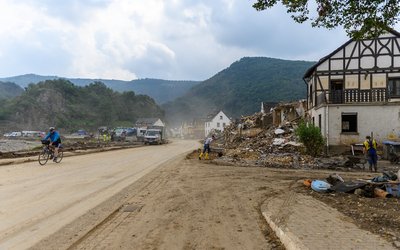Flash floods and urban flooding
Changing global patterns of urban exposure to flood and drought hazards
June 8, 2015

The impact of urbanization on the extent of urban areas exposed to flood and drought hazards has been assessed on a global scale, without factoring in the potential impacts from climate change. The results of this assessment are summarized below.
Urban areas in coastal zone
In 2000, over 10% of total urban land was located within the low-elevation coastal zones (LECZ, defined as ‘‘the contiguous area along the coast that is less than 10 m above sea level’’) that covers only 2% of the world’s land area. Most of the urban land in the LECZ was primarily located in the developed countries in Northern America and Western Europe along with China. By 2030, however, most of the urban land within the LECZ will be found in the developing countries. From 2000 to 2030, globally the amount of urban land within the low-elevation coastal zones is projected to increase by 230%; for Western and Eastern Europe this increase is projected to be 100% and 7%, respectively, resulting in 13% and 2% of the urban area being located in LECZ in 2030, respectively.
Urban areas exposed to high-frequency floods (coastal and river)
With respect to high-frequency flood zones, including exposure to both coastal and river floods, in 2000 about 30% of the global urban land was located in these zones; by 2030, this will reach 40%. For Western Europe these numbers are 34% (2000) and 34% (2030), and for Eastern Europe 9% (2000) and 10% (2030).
A broad shift is projected in the urban exposure from the developed world to the developing world from 2000 to 2030. The emerging coastal metropolitan regions in Africa and Asia will be larger than those in the developed countries and will have larger areas exposed to flooding. By 2030, India, Southern Asia, and South-eastern Asia are expected to have almost three-quarters of the urban land under high-frequency flood risk.
Urban areas in dry-lands
The urban extent in dry lands will also increase strongly. Across all regions and all dry-lands, most urban expansion is expected to occur in semi-arid regions of China. The most urban expansion in hyper-arid regions is expected in Northern Africa. For Western Europe the (projected) percent urban extent in dry-lands are 5% (2000) and 6% (2030), and for Eastern Europe 11% in both years.
Urban areas exposed to both floods and droughts
Overall, without factoring in the potential impacts from climate change, the extent of urban areas exposed to flood and drought hazards will increase, respectively, 2.7 and almost 2 times by 2030. Globally, urban land exposed to both floods and droughts is expected to increase over 250%. In particular, Southern Asia, India, and South America used to have the most urban land in 2000 in areas exposed to both frequent floods and to recurrent droughts. By 2030, Mid-Latitudinal Africa is expected to join these three regions in having the largest urban extents exposed to both floods and droughts. The largest increase in the amount of urban land exposed to both floods and droughts is expected in Southern Asia.
Source: Güneralp et al., 2015. Global Environmental Change 31: 217–225.
Photo: Chris Richards (www.flickr.com)








